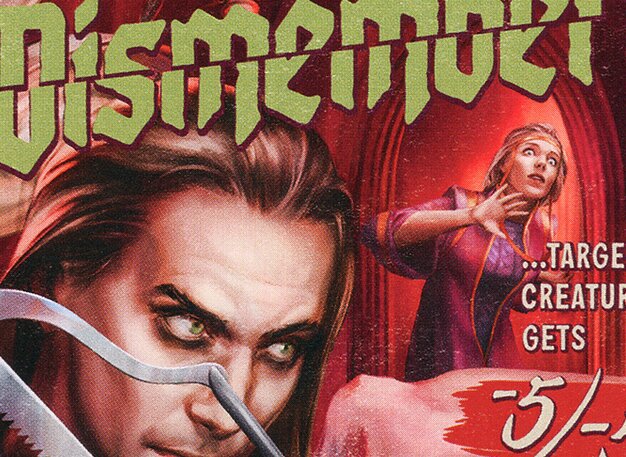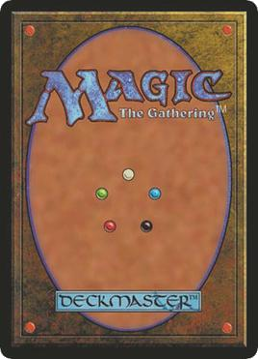 Art by Martin Ansin
Art by Martin AnsinHave you ever looked at a new Magic: The Gathering card - or rather purportedly a Magic: The Gathering card - and the art was so awful you wanted to quit playing, sell all your cards, and move to Siberia?
Well then this cube is for you. So-called because of the delightful art sprinkled throughout, the Heinous Cube aims to provide for compelling and interactive gameplay while making you want to lose consciousness instead of continuing to look at the cards in your hand.
Read below for a longer overview of the design principles. Move over to Visual View of the cube if you dare.
This cube was born in a pre-COVID era when I had a group of friends who had never cubed before and some of whom were new-ish to Magic. The goals were twofold: 1) to introduce a group of players who had mostly played low-stakes Standard FNMs and drafted Standard-legal sets to a novel and exciting draft environment; and 2) to sample the delights of 30 years of Magic cards while doing so. One of the game's strengths is its infinite variety, both in terms of card abilities and card art, and I wanted to develop a drafting experience that was enjoyable and compelling along multiple axes: the draft itself, deckbuilding, gameplay, and the aesthetics of the actual game pieces.
A nonnegotiable element of the original charter was that the cards don't provide the kinds of experiences that make Limited occasionally obnoxious: my opponent killed me on turn 2 and there's no response possible; my opponent played a Splinter Twin-esque combo I didn't even know they had and the game ended; my opponent played a protection from X creature and I went from winning to automatically losing. I wanted to avoid these situations partly because my cubing group was young in Magic terms but also partly because I dislike these gameplay experiences myself. As a cube designer, we get some selfish rewards!
Over a few years the cube evolved from a lower power level to a higher power level but the goals have always been the same: fun and interactive games underwritten by a drafting and deckbuilding experience that's skill-intensive and rewards maximizing deck equity as opposed to playing whatever broken stuff you can find.
The chief difficulty with this kind of philosophy is balance. Landing at a specific power level is already daunting, especially when most of Magic's history is available to you, but doing so while ensuring interactive gameplay that both players feel rewarded for engaging with is a neverending battle, especially as new cards cycle in and out. But it's also a fun battle, one that has many participants who are all my friends, and so one's complaints only sail so far before being subsumed into a shimmer of fellowship, laughter, and joy.
The biggest tentpole attribute of the cube and the most impactful decision that's ever been made during its lifetime is the elimination of planeswalkers entirely. I have long disliked planeswalkers as a card type for how they warp gameplay and their force in Limited is especially heinous. The game immediately focuses on a planeswalker the moment it resolves and completely inverts and undoes any game history revolving around tempo or card advantage. They're extremely punishing when ahead and lead to significant dissatisfaction from players. In addition, balancing a cube with planeswalkers is especially difficult. One has to decide what kinds of planeswalkers and then provide answers across colors to respond and interact with them. It constricts design space in weird ways: for example, Wizards loves printing 3 mana black spells that destroy a creature or a planeswalker - with no planeswalkers, those 3 mana spells can all become some other form of creature interaction and don't have to be 3 mana anymore.
Beyond the satisfying planeswalker genocide (I succeeded where Nicol Bolas failed), the next most impactful quality is that there are few archetypes across the colors drawn with thick black markers. Most of the archtypes are instead sketches with a fine-tipped pencil. It's up to the player to maximize synergies during the draft so that their deck is not just, say, a RW Aggro deck but rather a RW Aggro deck with a token subtheme or a RW Aggro deck that uses Blink effects to scale value into the late game.
There are some archetypes still visible from space. Reanimator exists across a few colors but most heavily in Black. It's slower and more controlling and the targets are often castable in the late game. Blink is a reliable strategy in White with help from Blue. Plentiful ETBs across the cube so White can pair with anything to achieve success. 2 color cards are sometimes signposts for a theme but not always and ideally they work well regardless of one's dedication to the subtheme. Generally, the goal of the cube is to generate fun and interactive games that don't end on turn 2 or 3 because of a combo and to reward players for drafting and playing well. If I've done my job right, all ten color pairs should provide quality gameplay using whatever strategy presents itself (aggro / midrange / control).
WHITE: Both aggressive and controlling. Great removal and most of it exiles. A couple hard sweepers and then some goofy temporary sweepers that require tact to deploy optimally. Interacts well with noncreature permanents. Midrange threats that scale well into the late game. Lots of things to blink and plenty of ways to blink them. A few reanimator elements (2 drop discard outlet, 4 drop reanimate spell, 3BW reanimate battle, fatties to enjoy putting into play). Often very aggressive when paired with Red or Black but with Black can be very controlling. UW is fliers / tempo most of the time (gold cards push this but are also just good cards outside a dedicated Blink deck). Larger value deck when paired with Green. Tokens subtheme that works well alongside sacrifice cards in Black and go-wide elements in Red and always good with Spear of Heliod and Honor the Pure (Goblin Trenches is always underrated).
BLUE: Lots of counterspells if that's your perversion. More tempo / controlling than aggressive but the fliers can punish slower draws from the opponent when backed up with bounce / counters. Plenty of things to Blink and a couple soft Blink abilities (Man-o-war-esque mostly but also 4 mana Thassa to blink every turn). Plays well with reanimator naturally by providing discard outlets and fatties (Hoverguard Sweepers is better than it looks). One build around in Rise from the Tides but it's pretty obvious and doesn't require a lot of investment in the draft to make work. WU is usually value / blink. UB control / reanimator. UR is usually tempo. UG ramps into large stuff and draws lots of cards.
BLACK: Sacrifice subtheme throughout that pairs well with token generators in White and Red but also does silly things with Black 1 drops that recur. Overall plays well across all strategies. Biggest reanimator color but most are slower and it's harder to get creatures into the graveyard before turn 3. Bigger creatures pair very well with White's Blink effects and Green's ramp. Great aggro color with Red or White. The Rock and His Millions are alive and well. UB is mostly control / reanimator but tempo is possible. Black generally is both obvious in its applications (removal, reanimator stuff) but also very fun to pair with other cards from other colors (sacrifice theme, tokens theme, tempo strategies).
RED: Naturally aggressive, lots of burn spells, but plenty of ways to be a complimentary midrange color or even control. Tokens subtheme but cards are typically 3 and 4 mana so they build up to something bigger (e.g. Hellrider + Ogre Battledriver making Rabblemaster / Warboss / Beetleback Chief very happy - but also Cloudgoat Ranger or Angel of Invention in White). Tokens subtheme pairs extremely well with Black's sacrifice cards and Goblin Bombardment and Burn at the Stake are quality finishers there. Red is perhaps a bit one dimensional but the decks it helps create (RG Stompy, RW Aggro with or without Tokens, UR Fliers / Burn, RB Sacrifice) are diverse and fun.
GREEN: Mana fixing and acceleration with the biggest creatures generally speaking. Good midrange threats, ability to deal with noncreature permanents, plenty of ramp payoffs, cards that add value turn after turn. 1 drop dorks can lead to RG Stompy and ways of accelerating out White's quality 3 and 4 drops. Can assist black with Reanimation and Simic decks tend to ramp and draw cards (what more is there in life?). 4c and 5c decks are always possible if the fixing arrives early enough (Farseek and so on + whatever's available in the Artifacts). Green hulks out a bit here in terms of wanting to win the ground battle with the best creatures but it has the cards to do cool things with all the other colors that aren't simply "put a 6/6 into play."
- Revival of the Ancestors
- Mardu Siegebreaker
- Soulstone Sanctuary
- Mirrex
- Cultivate
- Geralf's MessengerQarsi Revenant
- Sling-Gang LieutenantBarrowgoyf
- Braids, Cabal MinionPersistent Constrictor
- Pack RatSinkhole Surveyor
- Priest of Forgotten GodsRot-Curse Rakshasa
- Siege-Gang CommanderTersa Lightshatter
- Scute SwarmSurrak, Elusive Hunter
- Roar of the WurmHonored Hydra
- FarseekSpinner of Souls
- Cathartic ReunionCori-Steel Cutter
- Windbrisk HeightsFountainport
- Selesnya SignetArcane Sanctum
- Gruul SignetSandsteppe Citadel
- Rakdos SignetCrumbling Necropolis
- Izzet SignetSavage Lands
- Boros SignetFrontier Bivouac
- Orzhov SignetOpulent Palace
- Azorius SignetSeaside Citadel
- Dimir SignetJungle Shrine
- Golgari SignetMystic Monastery
- Simic SignetNomad Outpost
- Monastery MentorSevinne's Reclamation

